What’s a Transesophageal Echocardiogram?
A transesophageal echocardiogram (TEE) is a type of ultrasound test. Your doctor puts a tube down your esophagus with an ultrasound device that takes a series of moving pictures of your heart.
Your esophagus is the tube where food travels from your throat down to your stomach. It’s very close to your heart. So it’s a good spot to get accurate images of its chambers and valves as blood flows in and out.
A TEE can also show detailed pictures of the blood vessels attached to your heart and its outer lining (pericardium).
The test uses a small echocardiogram transducer, which uses sound waves to measure your heart’s rhythm as it beats. It’s placed on the end of a long, thin, soft tube called an endoscope.
Why Are TEEs Used?
Your doctor may use a TEE to see how blood flows through your heart’s valves. Along with AFib, it may help diagnose:
- Atherosclerosis
- Blood clots
- Strokes
- Heart failure
- Congenital heart disease
- An enlarged heart
- Pericarditis
- Tumors
- Tears in the wall of your aorta, a large artery
You may also need a TEE to check how well your heart works during or after surgeries like a bypass, valve replacement, or valve repair. Your doctor may also use it to check for blood clots before an AFib treatment called cardioversion.
Are There any Risks With This Test?
A few things can make a TEE too risky for you. This includes problems with your esophagus such as enlarged veins (esophageal varices), or having had radiation treatments in that area for cancer.
Possible risks of transesophageal echocardiograms include bleeding, breathing issues, or heart rhythm problems. You could also have injuries to your mouth, teeth, throat, or esophagus.
What to Do Before Your TEE
You’ll have your procedure at the hospital. You’ll be sedated, so you’ll need someone to drive you to and from your appointment.
Before your test, let your doctor know if:
- You’re pregnant or think you may be pregnant
- You take any medications or supplements for any reason
- You take aspirin, blood thinners, or anything else that could interfere with normal blood clotting, as you may need to stop taking them for a little while before a TEE
- You’re allergic to latex or anesthesia
- You have diabetes or take any medications to manage your blood glucose levels
Don’t eat or drink anything for at least 6 hours before the time scheduled for your TEE. Your doctor may also tell you not to drink any alcoholic drinks for a few days before your test.
Take any of your normal medications on the morning of your test. If it’s within 4 hours of your TEE, swallow any of your pills with only a sip of water, not a full glass.
What to Expect During Your TEE
At the hospital, you’ll change into a hospital gown.
You’ll lie on a table or bed with pillows so you’re comfortable. Your nurse will stick small, flat patches called electrodes on your chest. These patches measure the electric signals that your heart makes when it beats. Your nurse will put a blood pressure cuff around your arm and a clip on your finger to measure the oxygen levels in your blood.
To numb your throat for the test, your nurse may give you a solution to gargle and then spray your throat so you won’t feel anything. You’ll get a sedative through an intravenous tube into your vein. This will make you feel sleepy.
Then, they’ll slide the endoscope down your throat and esophagus. They’ll lubricate the tube so it goes down easily.
You may be a little uncomfortable while the endoscope is down your esophagus, but you’ll be able to breathe.
Your doctor may ask you to swallow a few times to shift the endoscope into the right spots to take accurate images.
Your doctor can move the endoscope around slightly to take several images of your heart from different angles. While you may feel movement, it won’t hurt. The whole test may take up to 90 minutes.
What to Expect After Your TEE
After your test, you’ll rest in a recovery area. Staff will watch your heart rate, blood pressure, and oxygen levels. Once those vital signs are stable, you can swallow normally, and you feel alert, your nurses will take off your chest electrodes, cuff, and clips, and remove your IV tube. You can sit up and then get dressed.
You may feel groggy after your test, so go home and rest. Eat the foods you usually do unless your doctor tells you otherwise.
The next day, you should feel normal. You may have a sore throat for a couple of days.
What Do Your TEE Results Mean?
Your doctor will go over your results with you. The images can show these problems:
- Changes in your heart’s size
- If your heart’s walls have become thicker
- How well your heart pumps blood
- If you have any extra tissue around your heart’s valves that suggest an infection or cancer
- If blood is regurgitating, or going back into your heart through its valves after each pump
- If you have narrowed or blocked heart valves
- If you have any blood clots, which could suggest you had a stroke
- Damaged heart tissue, which is a sign of a past heart attack
- Any abnormal connections between your heart and blood vessels, or between your heart’s four chambers

